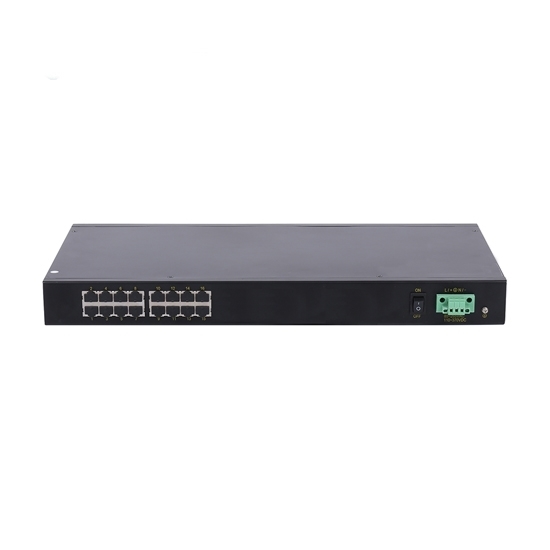
- Stock: In Stock
- Model: RDDLZ-ES-EN2016
- Weight: 1.00
- SKU: RDDLZ-ES-EN2016
Available Options
Cost-effective 16 ports industrial Ethernet switch, plug and play unmanaged switch, IP40 protection and wide operating temperature range from -40 to 85°C, suitable for harsh industrial environments.
Specification
| Model | RDDLZ-EN2016 |
| Technical Parameters | |
| Protocol Standard | IEEE802.3(Ethernet ), IEEE802.3u (100Base-TX & 100Base-FX), IEEE802.3x (Flow Control) |
| Switch Capability | |
| MAC Table Size | 8k |
| Backplane Bandwidth | 4.8Gbps |
| Switch Delay | <5μs |
| Interface | |
| 100M Port | Number:16 |
| Connector: RJ45 100M TX port | |
| Baud rate: Self-adaption 10/100Mbase-TX | |
| Terminal Block for Power Input | 5.08mm terminal block |
| Communication Distance | |
| Twisted-pair | 100m (CAT5/CAT5e cable) |
| LED Indicator Lights | |
| Front Panel LED Lights | Port light: LINK/ACT, SPEED |
| System work light: RUN | |
| Power status light: PWR | |
| Power | |
| Input Power | AC/DC 110V, 120V, 220V, 230V (85-264VAC/110-370VDC) |
| Power Consumption | <25W@(MAX) |
| Overload Protection | support |
| Inversed Protection | support |
| Working Environment | |
| Operating Temperature | -40°C~85°C |
| Storage Temperature | -40°C~85°C |
| Ambient Humidity | 5%~95% |
| Physical Characteristics | |
| Shell | IP40 protection, aluminum alloy shell |
| Installation | Standard 19-inch rack mounting |
| Dimension | 482.6mm × 44mm × 210mm (W×H×D) |
| Weight | 1.7kg |
| Industry Standard | |
| EMC | EN61000-4-2(ESD), Level 4 EN61000-4-3(RS), Level 4 EN61000-4-4(EFT), Level 4 EN61000-4-5(Surge), Level 4 EN61000-4-6(CS), Level 4 EN61000-4-8, Level 5 |
| Impact | IEC60068–2-27 |
| Falling | IEC60068-2-32 |
| Shock | IEC60068-2-6 |
Dimensional Drawing (mm)
Tips: The difference between Ethernet switch and router
1. The Ethernet switch is used to distribute network data. The router can automatically assign IP to your LAN, virtual dialing, like a traffic policeman, directing where your computer should go.
2. The Ethernet switch is at the relay layer, and the switch is addressed according to the MAC address. The router is at the network layer, the router is addressed according to the IP address, the router can handle the TCP/IP protocol, and the switch cannot.
3. The Ethernet switch can connect many hosts, and each of these hosts has its own IP. A router can assign an IP to a number of hosts, and these hosts only show one IP to the outside.
4. The router can provide a firewall, and the switch cannot provide this function.
